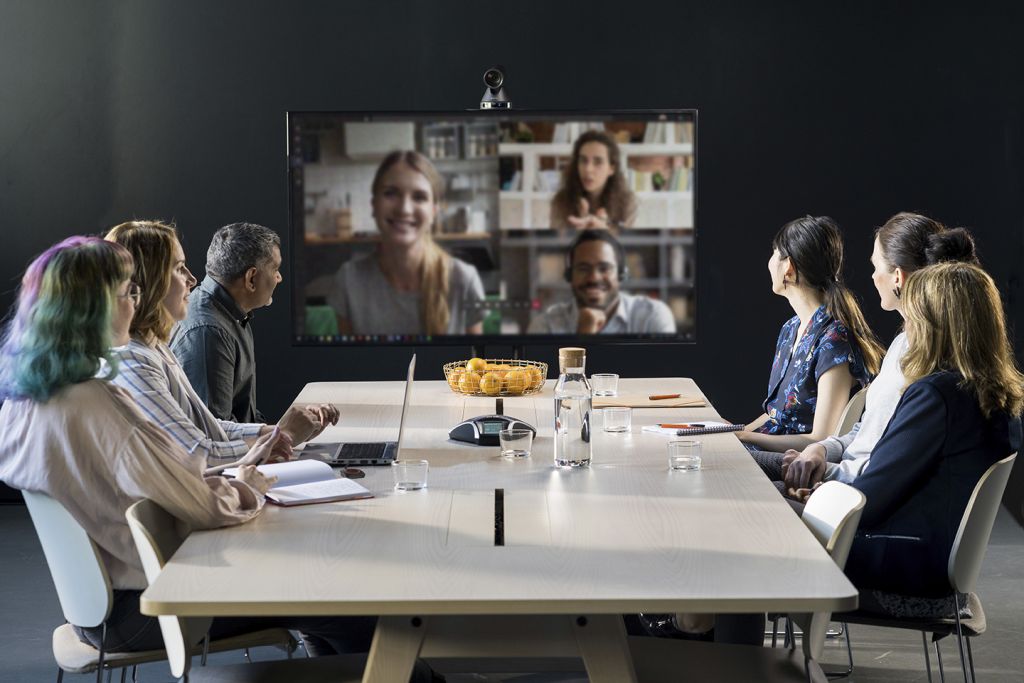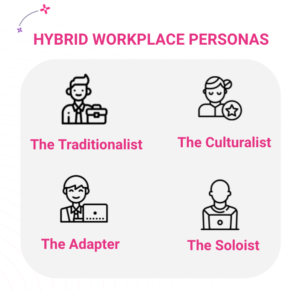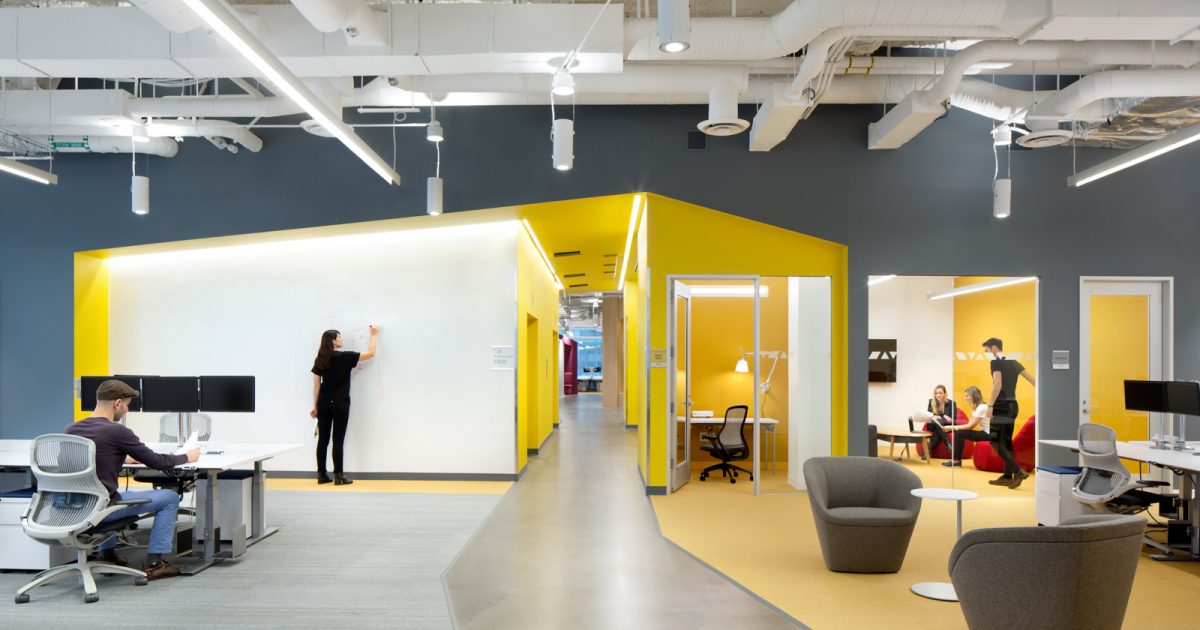Guide
To join the people-first world of work, it’s crucial to have a return to the office plan that not only takes care of the logistics and safety regulations, but also establishes a workplace that attracts and keeps the best talent.
This guide will help you address common hybrid working challenges and build a strong return to the office plan in 2022 that truly works for your people, which covers:

The time is now. The company is ready to use the office more regularly again, but do you have all the ins and outs of it figured out?
Merely rallying your team back to the office to rekindle focused, collaborative efforts and hope for efficiency and productivity won’t suffice. You need to know exactly how to reestablish the office for the new conditions.
This presents you with a unique opportunity to be a company where productivity and growth don’t come at the expense of mental and physical wellbeing – to create a people-first world of work.
It is therefore crucial that the return to the office plan you put together not only takes care of the logistics and safety regulations but also creates a great workplace experience that attracts and keeps the best talent with a powerful combination of choice, flexibility, and the best of both worlds – home and office, synchronous and asynchronous collaboration – here’s how to make it happen.

STEP 1
Before anything else, you need to be clear on what ‘hybrid’ will look like at your company.
The most common models are:
We can already see different companies choosing different hybrid models. Apple, Google, and Asana will require staff to be in the office part of the time. HubSpot and Salesforce offer their employees a choice between home, flex, and office work models. Meanwhile, Twitter and Facebook are offering the option to remain fully remote.
STEP 2
Our survey of 1,500 US and UK office workers revealed that the majority (54%) want to return to the office two or three days a week. To them, it’s comparable to going out to meet with friends.
But not everyone’s the same – twice as many Americans find the prospect of returning to the office more exciting than their British counterparts (62% versus 34%).
58% of US workers are convinced that the office return will improve both their mental health and productivity, expressing readiness to invest in time and money to travel to the office. This is three times more than UK workers, of whom less than a quarter (18%) are prepared to do the same.
The differences don’t end there – only 9% of women are prepared to be in the office five days a week, compared to 17% of men. According to Microsoft, the majority of working mothers and junior employees have been struggling at work during the pandemic, compared to only 39% of predominantly male business leaders with an established career.
of workers are convinced that the office return will improve both their mental health and productivity
want to return to the office two or three days a week
only 9% of women are prepared to be in the office five days a week
To make your return to the office plan and the new hybrid workplace experience a success, start by looking at the different personas in your organization.
Our research shows that you’re most likely to find these four hybrid working personas:

Conduct a return to office survey with your people to understand their needs, routines, collaboration and hybrid work preferences. Then define your hybrid working personas.
Knowing your employee personas will help you judge the most effective office configuration, the tools and support they’ll need, alleviate return to work anxiety, drive user adoption of the new desk booking app, and know exactly how to keep different employees engaged.
Send the survey to your employees to better understand how they prefer to work when they’re ready to return to the workplace.
Get tool kit
STEP 3
Without an inclusive culture, you risk waking up to an unequal workplace environment where those who choose to become remote-first feel left out or disadvantaged.
Over 55% of US and UK office workers say spontaneous conversations with colleagues are one of the best things about office life.
In-person meetings provide more opportunities for rich, informal conversations that build trust and strengthen emotional bonds with co-workers – something remote workers will find harder to achieve.
The way you approach the next phase of work, beyond the initial return to the office, will determine who stays, who goes, who wants to join, and how well the company performs. An effective employee retention strategy is key to success.
Nearly half (45%) of employees report feeling happier after chance encounters in the office. Around a third say they make them feel more motivated, creative, and productive.
Unsurprisingly, 44% of workers expect to have more of these water cooler moments after the office doors open. Most anticipate easier collaboration (60%) and better productivity (52%) once they get there.
Yet, many suffer from FORTO (fear of returning to the office) or return to the office anxiety. Employees across the globe are struggling with burnout, depression, digital anxiety, even a constant state of panic.
Nearly four in 10 (38%) British and American workers expect to choose when they come to the office.
An effective employee retention strategy is making sure your return to the office plan introduces a culture shaped around the people rather than the office. This creates a culture of trust with flexibility.
Visibility is key to building solid relationships, work recognition and value. To enable it, use a desk booking app that offers short- or long-term bookings and interactive floor plans that show which workspaces are booked, by whom, and at what time. With these two powerful features, people can decide exactly when to come to the office to maximize opportunities for chance encounters and collaboration.
As we move to hybrid working, it’s not just office space that needs to adapt – company culture needs to be inclusive and take into account the different needs of employees.
Read more
Employees expect a certain level of predictability when they come to the office. After a year-long pandemic, uncertainty about where or even how you’ll work can make it hard to adapt to the new office life. You may find your staff spending more time at home simply because it feels easier.
Whether it’s the transition to flexible working or new health and safety policies, timely and effective communication is key.
In other words, you need a smooth process for communicating changes and coordinating office hours and desk booking.
Explain the principles for internal decision-making and make sure everyone knows that any return to office plan is likely to change and evolve.
For even greater efficiency, prepare templates for the different situations most likely to occur:
Use a desk booking app that facilitates effective and timely communication with:
STEP 4
A scenario where an employee just grabs a random desk to work for a few hours is no longer acceptable. People worry about how returning to the office will affect their health.
39% of workers say they’ll no longer use shared kitchen areas, cups, and utensils in the workplace. A quarter (24%) won’t even use shared elevators. You need to be sure that you rally your troops safely, and so do they.
The first question to consider is the process – when and how you’ll open the office doors. Even if you decide to welcome everyone at the same time, developing different phases of office availability will ensure you’re prepared for any future scenario.
These could be:
Each phase will cover specific criteria for:
Finally, audit and update the cleaning and sanitization routines:
In a post-pandemic office economy, setting up a safe office workplace is not enough. Your return to the office plan needs to be agile and outline the process for achieving that.
You also need to:
The fastest and easiest way of making sure you’re always compliant with health and safety regulations is using digital tools that automate as much as possible of the process.
Look for features with:

STEP 5
Over a third (34%) of US and UK workers expect their employers to introduce more collaborative zones while 37% want extra quiet working areas, and another 26% would like to see pet-friendly working zones in the office.
Understanding whether you have the right type of spaces for your people is just the start. You also need to make sure that the workplace doesn’t become a string of worries – about the lack of touchless desk and room check-in, the inability to quickly locate the right resources or a conference room fit for a hybrid meeting, a cumbersome 15-minute process to launch a video call.
If the office is a bad experience, people will simply avoid it.
To motivate people to come in, the office needs to become a destination worth returning to – an environment where people can focus as well as enjoy collaboration, team building, and chance encounters that, instead of interrupting work and increasing anxiety, lead to creativity, new initiatives, and help projects move along faster.
To deliver that:
Once you’ve given your people the freedom to build their cadences, how do you know how much of their work will take place in the office? And when?
Microsoft found that more than half (54%) of their staff who had chosen to return to the office were spending less than a quarter of their time there.
You risk juggling days of an overcrowded office with days that leave it nearly empty. And then there are zombie bookings – people reserving a desk or a meeting room but not showing up, thus leaving others locked out of a workspace and you paying for a half-empty office.
The cost of renting and maintaining company real estate may soon become too high.
1. Understanding how much office space to keep will depend on:
2. Track whether spaces are used as planned
The only way to do it effectively is using desk and room booking software like Kadence that uncovers work patterns among staff with:
3. With these space utilization insights, you’ll be able to:
You’ll achieve two goals: optimizing the use of resources and improving the workplace experience.
Manually monitoring office capacity, allocating seating, keeping a register of who’s planning to come in or who booked a spot but didn’t use it, can quickly become a full-time job that turns into a negative experience for office managers as well as employees. In fact, a quarter (25%) of US and UK employees worry about just that – finding the right kind of workspaces once the office doors open.
Not knowing if your team will be at the office or working remotely is a challenge, too, especially when collaborating on projects. You don’t want employees to be waking up an hour earlier and suffering through a long commute only to end up working alone because none of the people they need to meet are there.
To facilitate return to the office, choose a desk booking app that optimizes workplace management:
And is convenient enough to drive user adoption.
With optimized desk and room booking experience as one of the pillars of your return to the office plan, you’ll not only save time and resources on logistics and facilities management but also strengthen work relationships that foster productivity and job satisfaction.
You’ll give your teams something to look forward to – a return to the office that perhaps felt uncertain now becomes exciting.
Book a demo with our team to discover how we can help you create a hybrid workplace for your people.
Book demo
Updates